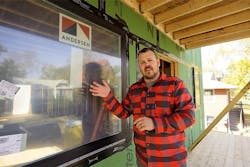Jake Bruton, President of Aarow Building, knows a thing or two about windows. “When we talk about window installation, what we’re doing is connecting control layers,” he says. “We’re looking for continuity in our water management, in our air control layer, and we’re looking for our thermal control layer to be continuous as well.”
In one residential project in Columbia, Missouri, Bruton’s team installed Andersen 100 Series windows and while there, he demonstrated his approach to installation when considering the water, air and thermal control layers.
Connecting the Control Layers
Before beginning the process, Bruton’s team places the window in the frame to ensure it’s level, plumb and square. They then check to ensure the window is perfectly positioned to cleanly open and close, lock and unlock within the frame. Once it is perfect, the sides and top are then screwed into the frame.
Now the water management phase can begin. Bruton uses ZIP System sheathing, tape and sealants with his Andersen Series 100 windows. Whether considering this system or another method of water control, Bruton explains it’s essential to fully understand what the sealant products need to do and how they work before making that decision.
His team first sealed the sides of the windows with the tape, then sealed the top jamb. They left the bottom flange of the window unsealed so that any water that might get into the opening would have a place to run off. Bruton explains that because this is outside of the building envelope and the inside is sealed, this does not pose a leakage problem. Bruton had the team waterproof the sill to mitigate any potential installation issues down the road.
To seal the bottom flange against air leaks, the team adhered the ZIP sheathing inside the rough window opening and a sealant was then applied to create an airtight barrier layer. For the home in question, a backer rod was installed behind the sealant to provide thermal control around the windows. Bruton doesn’t use spray foam insulation because it can create a mess if applied by an inexperienced carpenter.
The window’s water control layer was attached to the nailing flanges on the side and head jambs with the flashing tape. Then, the air and thermal control layers were connected through a single process by way of a sealant applied over the backer rod. Bruton used a liquid sealant for this project, but notes it can be a challenge to apply it with precision. If that’s a concern, a sealant tape could be used instead.
Finishing Touches After Installation
Once the windows were securely placed in the openings and the three control layers applied, the process was complete.
Bruton prefers to leave the 100 Series protective film on the inside of the windows for the entirety of the construction process to keep them clean. The team typically removes the film from the outside after installation to prevent having to do extra ladder work at the end of the project.
He adds that the fenestration stickers attached to every window need to be saved. Each label is specific to the window it was affixed to, is non-replaceable and contains important information for the homeowner.
Bruton concludes, “Now we have a window that’s securely fastened in the opening, is water-controlled on the outside, air- and thermal-controlled on the inside—and installation is finished.”
For more information, visit andersenwindows.com.

